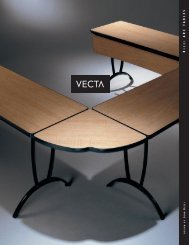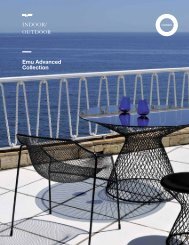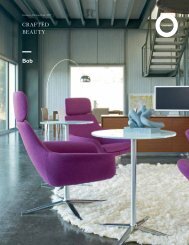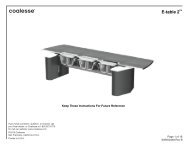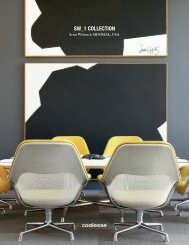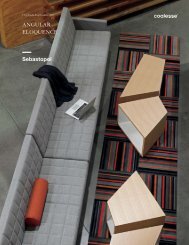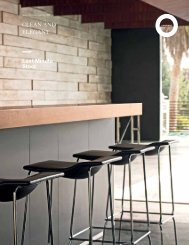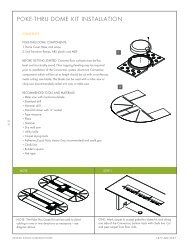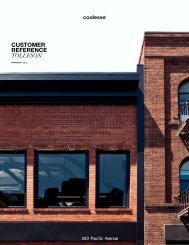Textile Variance Reference guide - Coalesse
Textile Variance Reference guide - Coalesse
Textile Variance Reference guide - Coalesse
Create successful ePaper yourself
Turn your PDF publications into a flip-book with our unique Google optimized e-Paper software.
TEXTILE VARIANCE<br />
REFERENCE gUIDE
Fabric <strong>Variance</strong>s<br />
TEXTILE<br />
VARIANCE<br />
Thank you for your interest in specifying <strong>Coalesse</strong> products. We wish to do all we can to<br />
assist you in your textile specification. Our comprehensive textile database provides our recommendation<br />
for textile applications based on our experience with textiles on our products.<br />
Please refer to this <strong>Textile</strong> <strong>Variance</strong> <strong>Reference</strong> <strong>guide</strong> for detailed information and images<br />
illustrating aesthetic variances in textile application.<br />
Please feel free to contact <strong>Coalesse</strong>, and we will work with you. Contact us at 800.627.6770<br />
for assistance, or go to: http://www.coalesse.com/fabric/FabricDatabase.html for our<br />
comprehensive textile database.<br />
2 .
3 .
Fabric <strong>Variance</strong>s<br />
What is<br />
A Backing?<br />
Backing is a coating applied to the back of textiles to stabilize<br />
and reinforce fabrics for upholstery use. It helps reduce fraying<br />
and seam slippage. It is typically not recommended for silks<br />
or thin woven textiles since backing may distort color slightly.<br />
Backing may be latex or acrylic material.<br />
BACKING<br />
Additional lead time and upcharges apply. Please contact<br />
Concierge Team for more information.<br />
what are<br />
stitching details?<br />
<strong>Coalesse</strong> seating upholstery includes many different stitching<br />
techniques in our upholstery process. Each is used in a variety<br />
of ways.<br />
1. Single needle is the basic most common stitch that is used on<br />
any sewn piece.<br />
2. Top Stitch is created by folding over the selvage of the single<br />
needle and sewing to one side on the top of the cover surface.<br />
It is used for detail on specific designs such as top edge of the<br />
Capa chair.<br />
3. Inverted Stitch or French Seam is created by trimming the<br />
selvage bringing the seam together and sewing the top edge<br />
together. This detailing technique is used to create a pillow<br />
such as the Chord Pillowback or LaCosta Couture chair.<br />
4. Double needle detail is created by special double needle<br />
equipment. The single needle seam is opened and stitched<br />
on both sides of the seam. This can be decorative to accent<br />
the piece or can be critical to the integrity of the chair. This<br />
technique is also used to create a zipper on specific models.<br />
5. Saddle Stitch is created in the same fashion as the Top Stitch<br />
or Double Needle; however a thicker thread is used to create<br />
the finished look. Saddle Stitch is used on designs such as<br />
our HolyDay lounge.<br />
Shown above is the Capa chair,<br />
notice the top stitch detail on<br />
the seat cushion.<br />
Double needle detail is used to<br />
create the zipper on the back of<br />
the Wrapp chair.<br />
4 .
Fabric <strong>Variance</strong>s<br />
TOP STITCH OR<br />
DOUBLE NEEDLE<br />
With some materials that have a raised pattern or rough texture,<br />
these stitching details cannot be properly achieved with the<br />
standard expected seam aesthetic. Raised patterns or rough textures<br />
may cause the stitching to appear misaligned, crooked, or “snaked”<br />
and with these textiles this cannot be eliminated.<br />
These stitching details are used on various <strong>Coalesse</strong> products and<br />
in some cases when used as a design aesthetic, it can be eliminated<br />
from the unit allowing you to continue with your textile selection.<br />
In such cases <strong>Coalesse</strong> would proceed, notating that any top<br />
stitch or double needle detail would be deleted and manufacturing<br />
would proceed with a single needle stitch. (Message you will see<br />
– NOT RECOMMENDED FOR TOPSTITCH OR DOUBLE<br />
NEEDLE – SINGLE NEEDLE APPLICATION WILL APPLYand<br />
this results in a PASS WITH CAUTION in the fabric<br />
database.)<br />
On other products, top stitch or double needle detail is used to<br />
create the pillow, zippers or may serve as a stress point. This type of<br />
stitch is then considered to be critical to the structural integrity of<br />
the unit. Without this detail, the cover would not upholster on the<br />
chair so Top stitch or Double Needle cannot be removed from the<br />
chair. In these cases you may choose to continue with your selection<br />
understanding the seam aesthetic variance that will occur since the<br />
stitch cannot be deleted. You may also choose to reselect an alternate<br />
textile. (Message you will see: NOT RECOMMENDED FOR<br />
TOPSTITCH OR DOUBLE NEEDLE ON THIS PRODUCT.<br />
TOPSTITCH OR DOUBLE NEEDLE DETAIL CANNOT<br />
BE REMOVED AND IS REQUIRED FOR STRUCTURAL<br />
INTEGRITY OF THE UNIT - and this results in a PASS WITH<br />
CAUTION in the fabric database.)<br />
Raised Texture / Double Needle<br />
Rough Texture / Top Stitch<br />
Double needle detail used to create<br />
the Zipper Detail (shown in a Rough<br />
texture textile)<br />
5 .
Fabric <strong>Variance</strong>s<br />
thick or stiff<br />
THICK OR STIFF: Some textiles are constructed of thicker<br />
or stiffer material. Based on the natural curves, zipper usage,<br />
welt, and design of <strong>Coalesse</strong> products, these thicker or stiffer<br />
textiles will not perform well on designs with these features.<br />
When textiles are too thick or stiff to use on selected products<br />
you must reselect and choose an alternate textile. : (Message<br />
you will see - TOO THICK OR STIFF - and this results in<br />
a FAIL WITH EXCEPTION in the fabric database and this<br />
textile may not be utilized.)<br />
Too Thick / Welt Detail<br />
horizontal stripe<br />
Certain textiles, most commonly synthetic leather or vinyl involving<br />
polyurethanes or nylon content, may stretch more in one direction.<br />
When this situation occurs we will specify an application direction<br />
for that textile to minimize stretch when applied to <strong>Coalesse</strong> products.<br />
The stretch cannot be eliminated; however, can be minimized<br />
with the proper application.<br />
At times these textiles may have a striped texture or pattern that will<br />
have to run horizontally on the product in order to ensure the correct<br />
application direction off the roll to minimize stretch.<br />
(Message you will see – HORIZONTAL STRIPE APPLICATION<br />
REQUIRED TO MINIMIZE STRETCH WITH THIS<br />
TEXTILE SELECTION and this results in a PASS WITH<br />
CAUTION in the fabric database.)<br />
On some models we do not recommend a horizontal stripe, such<br />
as on Circa. (Message you will see - HORIZONTAL STRIPE<br />
APPLICATION REQUIRED TO MINIMIZE STRETCH<br />
WITH THIS TEXTILE, HOWEVER HORIZONTAL STRIPE<br />
IS NOT RECOMMENDED ON THIS MODEL - and this results<br />
in a PASS WITH CAUTION in the fabric database.)<br />
6 .
Fabric <strong>Variance</strong>s<br />
TWO-WAY PATTERN<br />
Certain textiles involve geometrically-designed patterns that run<br />
both vertically and horizontally. Some <strong>Coalesse</strong> models, due to<br />
their naturally curved design including some <strong>Coalesse</strong> modular<br />
units, do not lend themselves aesthetically to a two-way pattern<br />
application. Modular units such as Circa which have units that<br />
curve out and in when connected and upholstered in geometricallydesigned<br />
patterns may appear to smile or frown from unit to unit as<br />
the pattern connects (see image below.)<br />
Please note proper match out of pattern cannot be achieved.<br />
Contrasting upholstery is recommended.<br />
TWO WAY PATTERN – SOLID OR RANDOM REPEAT<br />
APPLICATION RECOMMENDED, PROPER MATCH OUT<br />
CANNOT BE ACHIEVED WITH A TWO WAY PATTERN.<br />
Or<br />
TWO WAY PATTERN – CONTRASTING UPHOLSTERY<br />
RECOMMENDED FOR BIX BACKSCREEN ONLY, PROPER<br />
MATCH OUT CANNOT BE ACHIEVED WITH A TWO WAY<br />
PATTERN.<br />
Or<br />
TWO WAY PATTERN – CONTRASTING UPHOLSTERY<br />
RECOMMENDED FOR RIPPLE. PROPER MATCH OUT<br />
CANNOT BE ACHIEVED WITH A TWO WAY PATTERN<br />
All messages above result in a PASS WITH CAUTION in the fabric<br />
database.<br />
7 .
Fabric <strong>Variance</strong>s<br />
TWO-WAY PATTERN<br />
On some <strong>Coalesse</strong> products such as Ripple, you may also see a<br />
suggestion of using a contrasting upholstery. You may also choose<br />
to reselect and alternate textile.<br />
On some models a two way pattern cannot be applied such as the<br />
tack panels. (Message you will see – TWO WAY PATTERN – and<br />
this results in a FAIL WITH EXCEPTION and this textile may<br />
not be utilized.)<br />
8 .
Fabric <strong>Variance</strong>s<br />
WELT<br />
Welt is a cord-like material that is wrapped in your textile selection<br />
and is sewn together serving as a trim feature for bases, arms,<br />
and backs on many <strong>Coalesse</strong> products.<br />
Some textiles when wrapped around the welt cord may<br />
exaggerate a raised texture or separate raised fibers in the textile<br />
exposing the base material. In these cases you can continue with<br />
your selection but would need to be aware that application of<br />
this textile on the welt will create a visual on the finished product<br />
aesthetically that cannot be eliminated. In addition, we may<br />
suggest that you specify a contrasting upholstery on the welt that<br />
will not create the same aesthetic issue. (Message you will see –<br />
CONTRASTING FABRIC ON WELT IS RECOMMENDED<br />
- and this results in a PASS WITH CAUTION in the fabric<br />
database.)<br />
Raised Fiber<br />
Separation on Welt<br />
MEMORY<br />
Memory<br />
Some textiles when stretched have limited memory and will not<br />
return to their initial shape or appearance. With normal memory,<br />
a textile will quickly return to its normal shape when pulled<br />
in different directions. With light memory, the textile may not<br />
return to its normal shape or will be slow to return.<br />
When the application of a textile will result in stretch that will<br />
not return to its original form and results in wrinkling, these<br />
textiles are not recommended for use on <strong>Coalesse</strong> products.<br />
We recommend you reselect and choose an alternate textile.<br />
(Message you will see – MEMORY and it results in a FAIL in<br />
the fabric database.) You do have the option of continuing with<br />
your original textile selection; however, noticeable wrinkling or<br />
puddling may occur. <strong>Coalesse</strong> cannot be responsible for textile<br />
performance or aesthetic appearance with use.<br />
9 .
Fabric <strong>Variance</strong>s<br />
WRINKLE, PUDDLE,<br />
OR PUCKER<br />
Some textiles when combined with the natural curves and design<br />
of various <strong>Coalesse</strong> products will exhibit wrinkles or will puddle<br />
or pucker in various areas of the product. Certain <strong>Coalesse</strong> seating<br />
will show comfort wrinkles due to the design of the product.<br />
When the application of a textile will result in excessive<br />
puddling or wrinkling, these textiles are not recommended for<br />
use on <strong>Coalesse</strong> products. We recommend you reselect and<br />
choose an alternate textile. (Message you will see – WRINKLE,<br />
PUDDLE, PUCKER and it results in a FAIL in the fabric<br />
database.) You do have the option of continuing with your<br />
original textile selection; however, <strong>Coalesse</strong> cannot be responsible<br />
for textile performance or aesthetic appearance with use.<br />
10 .
Fabric <strong>Variance</strong>s<br />
TOO THIN /<br />
PANEL FABRIC<br />
Some textiles have been designed for use as panel fabrics or<br />
other applications that do not meet standard upholstery material<br />
requirements.<br />
When a textile is classified as panel fabric and you have selected a<br />
non-panel item, you must reselect and choose an alternate textile.<br />
(Message you will see – PANEL FABRIC – and this results in<br />
a FAIL WITH EXCEPTION in the fabric database and this<br />
textile may not be utilized.)<br />
CAT<br />
TEETH<br />
Some textiles especially thinner textiles or perhaps textiles with a<br />
heavier silk content will wrinkle or gather at the seams or when<br />
pulled in the upholstery process at the base of a unit.<br />
When the application of a textile will result in cat teeth we<br />
recommend you reselect and choose an alternate textile. (Message<br />
you will see – CAT TEETH and it results in a PASS WITH<br />
CAUTION in the fabric database.) You do have the option of<br />
continuing with your original textile selection.<br />
11 .
Fabric <strong>Variance</strong>s<br />
THREAD<br />
SEPARATION<br />
At seams, textile threads pull away from the seam when pressure<br />
is applied. Usually visible in textiles that have dark face and light<br />
back or vice versa. Thread separation usually occurs on fabrics<br />
of continuous filament yarns that are very smooth with a slick<br />
surface. It is also caused by loosely constructed fabrics.<br />
When the application of a textile will result in thread separation,<br />
we recommend you reselect and choose an alternate textile. In<br />
these cases you can continue with your selection, understanding<br />
the application of this textile on the product will create a visual<br />
on the finished product aesthetically that cannot be eliminated.<br />
You may also choose to reselect an alternate textile. (Message you<br />
will see – THREAD SEPARATION - and this results in a PASS<br />
WITH CAUTION in the fabric database.)<br />
12 .
Fabric <strong>Variance</strong>s<br />
LOOSELY<br />
WOVEN<br />
Some textiles are loosely woven and will unravel easily resulting<br />
in weak seams. With these textiles, adding a backing will generally<br />
not eliminate the issue.<br />
When a textile is classified as loosely woven, we recommend<br />
you reselect and choose an alternate textile. (Message you will<br />
see – LOOSELY WOVEN – and it results in a FAIL WITH<br />
EXCEPTION in the fabric database and this textile may not be<br />
utilized.)<br />
MISC. NOT<br />
RECOMMENDED<br />
Some textiles have resulted in field performance issues, and those<br />
issues do not meet any other classifications. However, we have<br />
clear performance issues that required upholstery replacements.<br />
Most textiles will fail or have a pass with exception based on our<br />
standard evaluation criteria so this is rare; however, it can occur.<br />
When a textile is classified as miscellaneous not recommend you<br />
must reselect and choose an alternate textile. (Message you will<br />
see – MISC NOT RECOMMENDED – and it results in a FAIL<br />
WITH EXCEPTION in the fabric database and this textile may<br />
not be utilized.)<br />
13 .
Fabric <strong>Variance</strong>s<br />
NOT RECOMMENDED<br />
FOR SINGLE NEEDLE<br />
Some textiles should not be used in a single needle application<br />
and require a stronger seam. Some <strong>Coalesse</strong> products only involve<br />
single needle stitching and as a result if a fabric is not recommended<br />
for single needle then it would not be recommended for<br />
use on this product.<br />
When a textile is classified as not recommended for single needle,<br />
and the product you are selecting is only produced with single<br />
needle stitching then you must reselect and choose an alternate<br />
textile. (Message you will see – NOT RECOMMENDED<br />
FOR SINGLE NEEDLE – and it results in a FAIL WITH<br />
EXCEPTION in the fabric database and this textile may not be<br />
utilized.)<br />
GLUE<br />
TEST<br />
Some <strong>Coalesse</strong> products have a glue process in the upholstery<br />
applications. Certain textiles will absorb the glue or allow glue<br />
bleed through and cannot be applied to these products.<br />
When a product requires gluing in the upholstery process and the<br />
textile will not work with glue then you must reselect and choose<br />
an alternate textile. We may in some cases require you add a<br />
backing to your textile to eliminate the glue bleed through. By<br />
adding a backing, you can then use your initial textile<br />
selection. (Message you will see – GLUE TEST – and it results<br />
in a FAIL WITH EXCEPTION in the fabric database and this<br />
textile may not be utilized.)<br />
14 .
Fabric <strong>Variance</strong>s<br />
LEATHER<br />
Some <strong>Coalesse</strong> Products may involve specific rules involving<br />
leathers or synthetic leathers.<br />
4 o’clock series Shell Back chairs – Shell back chairs have a wrap<br />
around upholstery method and as a result are not available in<br />
leather or COL. The leather when gathered in the wrap around<br />
upholstery technique is too thick to work effectively underneath<br />
the shell back. (Message you will see – CANNOT SPECIFY<br />
LEATHER ON THIS MODEL – and this results in a FAIL<br />
WITH EXCEPTION in the fabric database and this textile may<br />
not be utilized.)<br />
4 o’clock Series – Upholstered Loop Arm Option – You can<br />
specify upholstered loop arms, however they are only available in<br />
Leather or Steelcase Brisa. (Message you will see - LOOP ARMS<br />
ONLY AVAILABLE IN LEATHER STEELCASE BRISA.)<br />
This is not a pass or fail, but a reminder that if you do choose<br />
the upholstered loop arm option when specifying your 4 o’clock<br />
product that the material available for selection on loop arms is<br />
limited.<br />
Holy Day Lounge and Tables – Holy Day lounge seating and<br />
tables with leather have a unique option available for saddle<br />
stitching. Since this detail is only available on the models in<br />
leather unique models were set up for leather upholstery versions.<br />
If you select the Holy Day Lounge Leather model and try to specify<br />
a non-leather material the message you will see – LEATHER<br />
REQUIRED FOR THIS MODEL and it results in a FAIL in the<br />
fabric database. You should at this point go back and specify the Holy<br />
Day Lounge.<br />
If you select the Holy Day Lounge which includes the standard<br />
non-leather models and try to specify leather the message you will see -<br />
CANNOT SPECIFY LEATHER ON THIS MODEL and it results<br />
in a FAIL in the fabric database. You should at this point go back and<br />
specify the Holy Day Lounge Leather model.<br />
If you select the Holy Day tables, only the models available with<br />
Leather tops are loaded to the fabric database and if you tried to<br />
specify a non-leather material the message you will see - LEATHER<br />
REQUIRED FOR THIS MODEL and it results in a FAIL in the<br />
fabric database.<br />
15 .
Fabric <strong>Variance</strong>s<br />
OUTDOOR<br />
Some <strong>Coalesse</strong> products such as Emu have models designed for<br />
use outdoors and textiles designed for outdoor use should be<br />
specified on these products when ordering. If you plan on utilizing<br />
indoors there are specific Emu models set up for indoor use.<br />
(Message you will see on an outdoor model if you select a textile<br />
not designed for outdoor use – OUTDOOR – and it results in<br />
a FAIL WITH EXCEPTION in the fabric database and this<br />
textile may not be utilized.)<br />
Other <strong>Coalesse</strong> products are designed only for indoor use and<br />
<strong>Coalesse</strong> does not offer indoor/outdoor versions of these products.<br />
(Message you will see on an indoor model if you select a textile<br />
designed for outdoor use – OUTDOOR – and it results in a<br />
FAIL WITH EXCEPTION in the fabric database and this<br />
textile may not be utilized.)<br />
BACK SEAMS<br />
REQUIRED<br />
On certain models that are standard with no seams, textiles such<br />
as those with aligned patterns or those that may be thick or stiff<br />
will require the addition of back seams to enhance the upholstery<br />
aesthetic.<br />
SEAMS<br />
On Lox with the upholstered back option, the inside back will<br />
have the addition of single needle stitch seams with certain<br />
textiles to allow <strong>Coalesse</strong> to expand the textile offerings that<br />
may be used on the product. When you have selected a textile<br />
that requires the addition of seams you may reselect if you<br />
prefer a seamless back or you can continue with your selection.<br />
(Message you will see – BACK SEAMS REQUIRED - ON<br />
CERTAIN MODELS THAT ARE STANDARD WITH NO<br />
SEAMS, TEXTILES SUCH AS THOSE WITH ALIGNED<br />
PATTERNS OR THOSE THAT MAY BE THICK OR STIFF<br />
WILL REQUIRE THE ADDITION OF BACK SEAMS TO<br />
ENHANCE THE UPHOLSTERY AESTHETIC and it results<br />
in a PASS WITH CAUTION in the fabric database.)<br />
16 .
Fabric <strong>Variance</strong>s<br />
CANNOT<br />
USE REPEAT<br />
Tack panels are a one piece design, fabric will be railroaded for<br />
consistent application. Matched pattern, directional, or striped<br />
fabrics may not be specified on tack panels. Self-healing fabrics<br />
are recommended. (Message you will see- CANNOT USE<br />
REPEAT - and it results in a FAIL WITH EXCEPTION in the<br />
fabric database and this textile may not be utilized.)<br />
APPLICATION<br />
ISSUE<br />
There are occasions when <strong>Coalesse</strong> has had a specific experience<br />
with a textile in our manufacturing processes and determined<br />
the textile will not work on specific products based on finished<br />
results. The issues for that textile may not specifically match<br />
current issues previously defined; however, we still do not recommend<br />
the textile for use and fail that textile on a specific product.<br />
When this occurs since no other issue specifically defines the<br />
challenge we will indicate an Application Issue. (Message you will<br />
see- APPLICATION ISSUE - and it results in a FAIL WITH<br />
EXCEPTION in the fabric database and this textile may not be<br />
utilized.)<br />
17 .
Fabric <strong>Variance</strong>s<br />
Striped textile<br />
Certain textiles involve stripes that can be in contrasting colors<br />
to the main textile background or they could be more subtle<br />
tone-on-tone stripes. <strong>Coalesse</strong> applies stripes vertically unless<br />
otherwise instructed; however, some <strong>Coalesse</strong> models due to<br />
their naturally-curved design may not lend themselves aesthetically<br />
to a stripe application, and only vertical application is<br />
recommended.<br />
When a textile involving a striped pattern has been selected for<br />
use on one of the <strong>Coalesse</strong> products with a curved design that<br />
aesthetically does not lend itself well to stripes, you will receive<br />
a notice. In these cases you can continue with your selection,<br />
understanding the application of a stripe on this model does<br />
create a potential concern on the finished product aesthetically<br />
that cannot be eliminated when using this textile. On some<br />
<strong>Coalesse</strong> products, such as Ripple or Bix, you may see a caution<br />
suggesting the use of contrasting upholstery. You may also<br />
choose to reselect an alternate textile. On other product such<br />
as Circa you may receive a caution stating that striped fabric<br />
must be applied vertically. : (Depending on the model you<br />
will see one of the following messages: STRIPED TEXTILE<br />
– SOLID OR RANDOM REPEAT APPLICATION<br />
RECOMMENDED, PROPER MATCH OUT CANNOT<br />
BE ACHIEVED.<br />
Or<br />
STRIPED TEXTILE – STRIPES MUST BE APPLIED<br />
VERTICALLY ON THIS MODEL.<br />
Or<br />
STRIPED TEXTILE – CONTRASTING UPHOLSTERY<br />
RECOMMENDED FOR BIX BACKSCREEN. SOLID<br />
APPLICATION RECOMMENDED FOR BACKSCREEN<br />
ONLY, PROPER MATCHOUT CANNOT BE<br />
ACHIEVED.<br />
Or<br />
STRIPED TEXTILE – CONTRASTING UPHOLSTERY<br />
RECOMMENDED FOR RIPPLE. PROPER MATCH OUT<br />
CANNOT BE ACHIEVED WITH A STRIPE.<br />
Vertical Stripe / Circa<br />
Vertical Stripe / Contrasting <strong>Textile</strong> / Circa<br />
Vertical Stripe / Circa<br />
All messages above result in a PASS WITH CAUTION in the<br />
fabric database.<br />
Horizontal Stripe / Circa<br />
18 .
coalesse.com 1.866.645.6952




